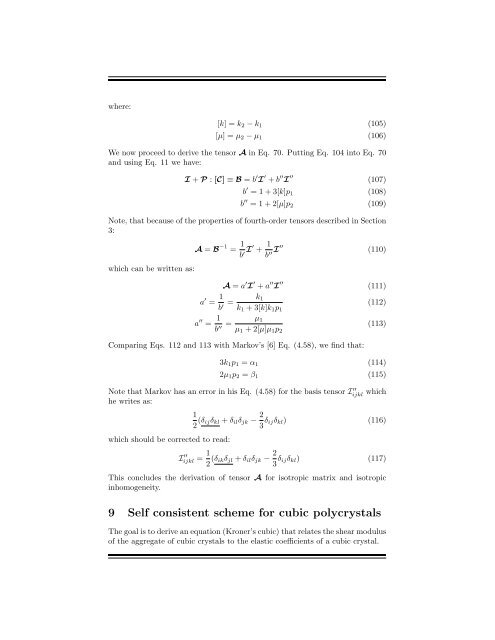Create successful ePaper yourself
Turn your PDF publications into a flip-book with our unique Google optimized e-Paper software.
where:<br />
[k] = k 2 − k 1 (105)<br />
[µ] = µ 2 − µ 1 (106)<br />
We now proceed to derive the tensor A in Eq. 70. Putting Eq. 104 into Eq. 70<br />
and using Eq. 11 we have:<br />
I + P : [C] ≡ B = b ′ I ′ + b ′′ I ′′ (107)<br />
b ′ = 1 + 3[k]p 1 (108)<br />
b ′′ = 1 + 2[µ]p 2 (109)<br />
Note, that because of the properties of fourth-order tensors described in Section<br />
3:<br />
which can be written as:<br />
A = B −1 = 1 b ′ I′ + 1<br />
b ′′ I′′ (110)<br />
A = a ′ I ′ + a ′′ I ′′ (111)<br />
a ′ = 1 b ′ = k 1<br />
k 1 + 3[k]k 1 p 1<br />
(112)<br />
a ′′ = 1<br />
b ′′ = µ 1<br />
µ 1 + 2[µ]µ 1 p 2<br />
(113)<br />
Comparing Eqs. 112 and 113 with Markov’s [6] Eq. (4.58), we find that:<br />
3k 1 p 1 = α 1 (114)<br />
2µ 1 p 2 = β 1 (115)<br />
Note that Markov has an error in his Eq. (4.58) for the basis tensor I ′′<br />
ijkl which<br />
he writes as:<br />
which should be corrected to read:<br />
1<br />
2 (δ ijδ kl + δ il δ jk − 2 3 δ ijδ kl ) (116)<br />
I ′′<br />
ijkl = 1 2 (δ ikδ jl + δ il δ jk − 2 3 δ ijδ kl ) (117)<br />
This concludes the derivation of tensor A for isotropic matrix and isotropic<br />
inhomogeneity.<br />
9 Self consistent scheme for cubic polycrystals<br />
The goal is to derive an equation (<strong>Kroner</strong>’s cubic) that relates the shear modulus<br />
of the aggregate of cubic crystals to the elastic coefficients of a cubic crystal.



